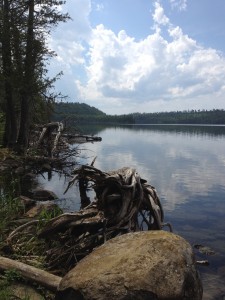Thursday, September 27th, 2012...9:24 pm
A summer with the feds
Over the summer, my morning commute to the office was a quick paddle into the wilderness. Life jackets replaced seatbelts and wind conditions were more of a concern than traffic jams. Parallel parking along the lakeshore was a dream.
Ok, the term office is relative—in this case, the office is a million-plus acres of wilderness, known as the Boundary Waters Canoe Area Wilderness in northern Minnesota. There are more than 3,000 lakes in this area, which straddles the U.S.-Canadian border, and it’s just a hop-skip away from Lake Superior, the largest freshwater lake in the world. Needless to say, the landscape is enchantingly beautiful.

Duncan Lake in the Boundary Waters Canoe Area Wilderness, just a few miles from the Canadian border.
Not to mention that it is nearly impossible to travel without a canoe in the Boundary Waters—which is what makes this area so unique. And this summer, I called this place both my office and my home.
As a student worker for the U.S. Forest Service, the government agency that manages the Boundary Waters, I work alongside Wilderness Rangers in the Superior National Forest. You could say I was a Wilderness Ranger-in-training, no big deal.
The Boundary Waters is a protected wilderness area that lies within the forest, and it’s also the most visited wilderness in the country. That means there are over 200,000 visitors each year—most of them come in the summer, and nearly all of them paddle in via canoe to camp, fish and enjoy the mysterious allure of the Boundary Waters.

The Boundary Waters Canoe Area Wilderness is located within the Superior National Forest in northern Minnesota. Image source: U.S. Forest Service
And that’s where we come in. Wilderness Rangers camp out in the Boundary Waters for 4-8 days at a time to maintain campsites, trails and speak with visitors. We paddle several miles a day. We cut down trees, dig latrines, and move rocks around to prevent erosion in certain areas. It can also be hot and strenuous—I easily drank at least 16 cups of water a day when I was working. But mostly, it’s also a lot of fun, and I loved my job.
One of the most important parts of our jobs is educating visitors—we check permits and discuss Leave No Trace principles with people to ensure they are practicing proper wilderness ethic, like packing out all of their trash and leaving as little impact as possible. That’s not always the case though, and let me tell you, I’m pretty much a pro at picking little bits of aluminum foil out of the ashes in fire grates.

That’s me, sitting on a new latrine. My co-worker and I dug a huge hole and put that toadstool on top of it, that’s the finished product 4 hours later.
The wilderness way is entirely sustainable—you bring in all of your gear, from food to clothing to canoe—and you bring it all out. The trick is to leave the area as pristine as possible, as if you weren’t even there in the first place.
For example, trail maintenance sometimes involves cutting down trees that have fallen across the portages, or the trails on land between the lakes that people use to get from one lake to the next. Down trees can pose a safety hazard because people are often carrying a lot of gear, like a canoe, and a person’s line of vision is severely limited with a canoe over their head. We buck the tree into smaller pieces, and carry the logs into the woods. Then, we smear dirt over the freshly cut faces of the tree trunks that are near the trail. We call this naturalizing, and it’s all about blending our work in with the natural surroundings to make it less obvious that a tree was just cut down.
After a summer of paddling, digging latrines, and learning about land management in the wilderness in the best of ways—by actually doing it—I’ve come away with a solid foundation for a wilderness ethic that I know I’ll follow and build upon for the rest of my life. And this applies to every day life as well, whether or not I’m in the wilderness. Limiting my personal impact in an urban environment is a big part of what I think about each day, and when I’m riding my bike to school up one of those infamous south Austin hills, I think about paddling to work in the Boundary Waters and remember that sometimes you have break a sweat to get what you want—and where you want to be.
1 Comment
October 4th, 2012 at 9:46 pm
Wow!! this is really incredible!! I really like your use of extra photos and the map to expand on your article.